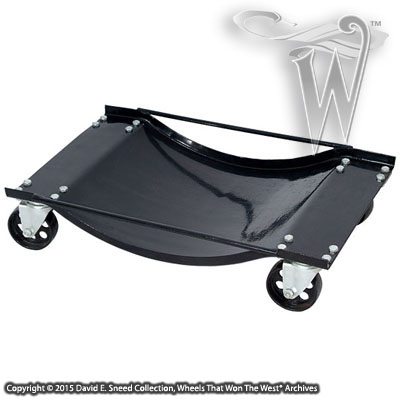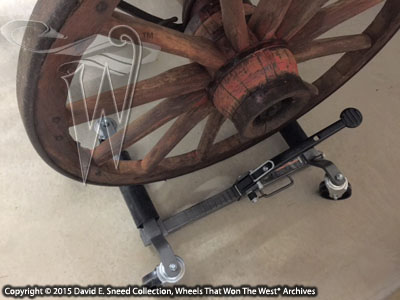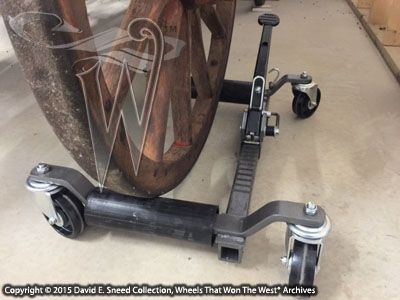If you own an old wagon, at some point, you'll likely want to move it. Maybe you're just rolling it across the floor a few feet or possibly hauling it completely across the county. Whatever the plan, the process should be done with plenty of forethought and care. After all, the downside of getting in a hurry has the potential of creating a less-than-positive experience. Over the years, I've actually come across folks as they were gathering the shattered pieces of a family treasure scattered along the highway. Stories like that, with pieces coming loose on an open trailer, are the kind no one wants to encounter.
I'll share some details about methods of and preparations for long-distance hauling in a later blog. Today, though, we'll cover something that hits even closer to home - moving a wagon within an enclosed space like a shop or garage. In and of itself, the moving activities aren't something that would typically warrant many comments - even for a short blog. With that said, it can be easy to overlook obstacles within tight quarters and it's not always possible to undo a mistake. Ultimately, no matter how far you're moving a piece of history, you'll want to do all you can to protect it.
If some of this sounds a bit over the top, let me share some negative things that can happen - even if an old wagon is only being rolled a few feet...
- Loose tires falling off
- Spokes being manhandled and pulling loose from felloes or hubs
- Other weakened wooden elements loosening and becoming less stable
- Severely worn rub irons getting hit by sudden turns of a wheel with the possibility of them breaking in half
- The wagon hitting and damaging something while marring itself or another vehicle.
Truly, there are countless unforeseen problems we can run into when moving an older vehicle inside a structure. Vigilance is always important in the process and, no matter how limited the space, never drag or skid a wagon sideways against the floor surface. Those actions can severely weaken and heavily damage the wheels and other parts. So, what's the best way to move a heavy, antique wagon in a crowded environment? The first thing to remember is that the more the vehicle is handled, the more opportunity there is for something to be damaged.
As long as the floor is of a relatively smooth and solid type - concrete, wood, tile, tightly woven carpet, or even asphalt -one of the best ways is to use individual car wheel dollies. There are multiple types of dollies and each has its benefits. One of the least expensive is a fixed position dolly. The downside to this one is that it requires a jack to be placed under the wagon axle so the dolly can be placed under each of the wheels. I've used these and like them but have never been comfortable with jacking up the wagon. It leaves too much opportunity for the jack to fall and parts of the wagon to be damaged.
 |
| Fixed position (non-jacking) dollies are inexpensive but require a separate jack to be placed under the wagon axles. |
My favorite types of dollies are those with built-in hydraulic jacks. These smooth-rolling tools sit on four caster wheels, permitting 360 degrees of movement. The handy devices are U-shaped to slip in around the base of the wheel and allow you to jack them up without the instability sometimes encountered from using taller, stand-alone jacks. With carrying capacities up to 1250 to 1500 pounds each, the only downside I've found is they can be a little pricey. A set of four can run from $350-400 or more - depending on the size. The base set I use was designed for cars with tires up to 32 inches in diameter. Translated into wagon wheel sizes, this particular dolly works well for wagon wheel heights measuring up to 45 inches. With that said, I have done some angling and finagling that allowed the same dolly to work on narrow-tired, 52-inch wheels. A better size for these higher 52-inch wheels would be jacking dollies made for car tire diameters up to 36 inches. Of course, they're a bit more expensive.
The other benefit of these types of dollies comes into play with vehicles that are stationary for long periods of time. Whether in a museum setting or private collection, wheels should be rotated on a regular basis to relieve and even out stresses. The self-jacking dollies I use actually allow the wheel to be spun fairly easily while it's raised, making it a simple task to rotate wheels without moving the wagon. They're relatively easy to find on the internet and in certain automotive outlets. Amazon, Harbor Freight, National Tool, and others carry both the self-jacking dollies as well as the fixed position designs.


Car dollies with built-in jacks allow 360 degree movement. Their use can make the process of moving wagons on solid surfaces quick and easy.
At the end of the day, these types of car wheel dollies can make a challenging job of wagon moving quite easy, in spite of tight quarters. The cost, ultimately, is a small price to pay for something you likely have a lot more invested in... And, for the hard-to-buy-for collector, this just might be the unique Christmas or birthday gift you've been looking for!
By the way, if you haven't signed up to receive NOTIFICATIONS each time we add to the blogs, articles, and other areas of the 'Wheels' website, it's easy to do. Just click on the SIGN UP banner in the upper right of our website. We're looking forward to your visits. Have a great week!
David
Please Note: As with each of our blog writings, all imagery and text is copyrighted with All Rights Reserved. The material may not be broadcast, published, rewritten, or redistributed without prior written permission from David E. Sneed, Wheels That Won The West® Archives.